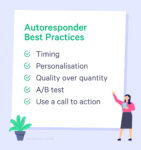BLOG
Benefits of Autoresponders & How to Use Them
48 hours. That’s how long a new lead is the most engaged with your brand for.
With such a short amount of time, businesses need to make it easy for prospects to interact with them in order to snap up those sales opportunities while they’re hot.
An autoresponder might not sound like the sexiest tool in the lead gen tool box, but including SMS and email autoresponders is an excellent way to interact with leads early on in their customer journey.
Keep reading to learn more about autoresponder benefits and best practices.
Take control of the customer experience
An autoresponder offers you some control of the customer experience as it sets the tone for your continuous communication with the customer.
Being seen and interacted with as a brand is important to drive sales. Salesforce found that it takes 6-8 branded touchpoints to generate a viable sales lead. This is something we live by here at Social Garden, and we know the impact an added touchpoint like an autoresponder has on conversion.
Creating an additional touchpoint also improves the experience for the customer. In high value purchases, such as buying a property, trust in the brand and their process is central.
The more positive experiences you have with a business, the better. Your email or SMS autoresponder might be just a confirmation, but that small acknowledgement tells the customer you are legitimate and care about having a relationship with them.
How to use an autoresponder
The beauty of an autoresponder is that they are very easy to set up: all you need is a few lines of text and you’re all set. Plus, you don’t even need to use fancy branding and creatives, some argue a plain text email is more effective!
Most often, autoresponders are in the form of an email but don’t overlook the power of SMS. We have found that autoresponder SMS have a 98% open-rate whereas email open-rates are on average 20%.
So if you want to get up and close with your leads, slide into their messages.
Autoresponder best practices
We can talk about welcome email best practices forever, but what it all boils down to is A) Timing and B) Being customer friendly.
1. Timing
Some argue that an autoresponder should go out within 24 hours, but you didn’t hear that from us. We believe both email and SMS autoresponders should go out immediately. Today’s impatient customer would expect nothing less.
2. Personalisation
Including the name of the customer in the email is a simple way of capturing their attention and making it feel more personal. Similarly, don’t forget to make it straightforward for someone to reply to you. Litmus says ‘No to no-reply email addresses’ and we couldn’t agree more. Think about what email address and name you are using, and consider having someone at your company sign off the email.
3. Quality over quantity
Stats don’t lie, the attention span of today’s customer is short. Your customer will give you 5 seconds before labelling your email as spam. As such, you want to make sure it’s clear who the email is from and what the content is. We recommend aiming for a scannable layout, concise text and a clear CTA.
4. A/B test
The first email has four times the open rate and five times the click-through-rate to a standard email campaign. But as with any email, the subject line needs to be engaging. If you are deciding between multiple subject lines, A/B test it and let your customers decide which is the winner for you.
5. Use a call to action
A thank you email is all well and polite, but take the opportunity to engage with your customer. A subscriber is more likely to engage with your first email than your fifth, so guide them to take that next step while you’ve got them hooked.
What’s the next step?
Depending on what triggers an autoresponder, there’s usually a next step you can gently nudge your customer to do, such as:
- Download content
- Profile themselves and personalise their experience
- Book an appointment
Providing them with additional content is common, like a brochure or having them click to an article on your website. Asking your customers what they are interested in, and directing them to a profile page is also great for collecting more information on their level of intent and preferences.
Better yet, a timely autoresponder offers an opportunity for conversion and lets them request an appointment with you on their own terms. At Social Garden, a vast majority of our client’s appointment requests come from that first autoresponder email – revealing the value of added touchpoints that empower consumers.













